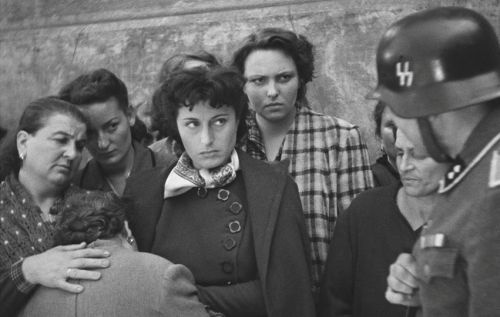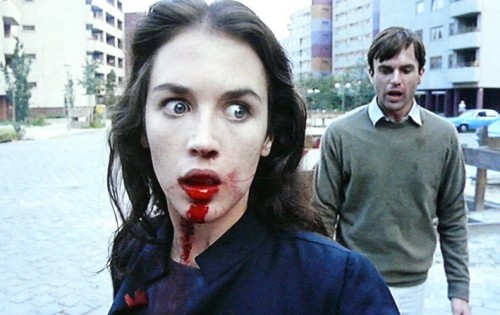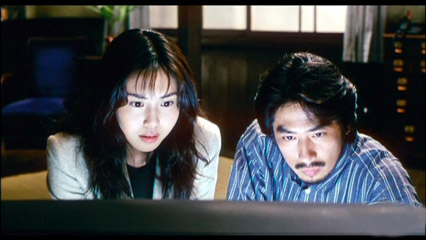
This is a guest post by Giselle Defares.
Italian neorealism. Who would have thought that a genre that existed for a short period of time–1944 to 1952 to be precise–could have such a significant influence in the world’s cinematic history? The quintessential works of the Italian neorealist directors such as Vittorio De Sica (Ladri di biciclette), Luchino Visconti (La Terra Trema, Ossessione) and Roberto Rossellini (Roma, città aperta) are now anchored in our cultural lexicon. The genre has influenced the work of famed directors such as Truffaut, Antonioni and Godard. After all, didn’t Jean-Luc Godard state “All roads lead to Rome, Open City”?
Roma, città aperta, the first part of Rossellini’s neorealistic trilogy, is often cited as the prime example of the neorealist genre. In ravaged Rome of 1945, recovering from Nazism and fascist oppression, Rossellini formed a team with Federico Fellini and Sergio Amidei to create two documentaries. Amidei and Fellini encouraged Rossellini to combine the scripts to create realistic fiction. The film was shot on location in Rome on a shoestring budget (mustered with many loans). Rossellini used parts of a 35 millimeter film and the scenes were silently shot–Renzo Rossellini would later post-synchronize the sound. Voilá, Roma, città aperta was born.
The neorealist movement arose as a reaction against the glamorous melodramas that had previously dominated the Italian film industry under the dictatorship of Benito Mussolini. The fascist Mussolini used cinema as a place where the Italian citizen could dream of the lush–unattainable–images and temporarily forget their own harsh reality a.k.a cinema of distraction.
The neorealist directors sought out to present a degree of unfettered realism that wasn’t presented on the Italian silver screen. The films addressed social problems such as the ravages of war, crime, unemployment, and poverty. The sense of immediacy throughout the film–scenes shot in locations where eight months before the city was occupied by the Nazis–had no correlation with any other Italian film produced in the 40s. Upon its release, Roma, città aperta, was received with mixed reactions in Italy. Luckily the rest of the world was transfixed by this form of new realism. The film won the Grand Prize at the Cannes Film Festival in 1946. Fellini, Rossellini, and Amidei were nominated for an Oscar for Best Adapted Screenplay.

Roma, città aperta centers around the plight of the core members of the Italian resistance against the occupational Nazi government. We follow Giorgio Manfredi also known as Luigi Ferraris (Marcello Pagliero), a communist and leader in the resistance who’s wanted by the Nazis. His friend and underground Communist newspaper printer Francesco (Francesco Grandjacquet); his fiancée, the widow Pina (Anna Magnani); and the priest Don Pietro Pellegrini (Aldo Fabrizi). The trio will help Manfredi get a new identity. Pina’s son, the young Marcello, has been active in the resistance against the Nazis. In the tumultuous events that follow, Francesco is arrested but later manages to escape. While Manfredi gets betrayed by his lover, femme fatale pur sang, Marina (Maria Michi).
Most research on the film–see for example the work of David Forgacs, Peter Brunette, Tag Gallagher–is focused on the politics of filming, the catholic church, or other neo-realist features. Not much is written on the archetypical roles of the women in this film (bar the work of Marcia Landy. The character development of Pina and Marina used by Rossellini shows the influence of the war on Italian life and femininity. The suffering women are the epitome of the country at war.
Fascism encouraged the rise of the so called New Italian Women (Nuova Italiana). During Mussolini’s reign, Italian women struggled with the dilemma of the lure of modernity versus the rut of tradition. Though their freedom was curbed: no voting rights for women, no female participation in the labor market, and a ban on abortion. The role of the women herein was in essence purely to bring forth children. These contradictions were emphasized by the gap that existed between the traditional Italian society of the First World War and the division of modernity that fascism entailed. In 1933, Mussolini’s stated, “ Woman must obey… My idea of her role in the State is in opposition to all feminism. Naturally she shouldn’t be a slave, but if I conceded her to vote, I’d be laughed at. In our State, she must not count.” Right.

In Roma, città aperta we are introduced to two archetypes. First, the headstrong Pina, the rock who supports her husband, yet is allowed to be vulnerable. Then there’s Marina, the “weak” and venal woman who will succumb to all her desires. This dichotomy between Pina and Marina is the classic example of the Madonna-whore complex. Marina is presented as the complete opposite of Pina. Pina can be seen as the new Italian woman. Her whole look and attitude throughout the film is that of an ordinary, disheveled woman. She almost seems stripped of her “femininity.” This is a stark contrast with Marina, who works as a showgirl and enjoys her silk stockings, fur coats, and cigarettes – all the finer things in life. Marina seems like the new embodiment of the earlier femme fatales that reigned in the Fascist cinema–women who lived by no discernible laws and destroyed men who crossed their paths. Although, Rossellini’s version of the femme fatale is portrayed as a frail woman. Marina doesn’t fully embody the vivacious and sexual role the previous Italian femme fatales had. She’s doesn’t sashay her way through life, instead she’s considered weak and unable to deny herself any desires. This is also illustrated by Rossellini’s portrayal of her “liaison” with the Nazi Ingrid (and to underline the “moral depravity” during the war). It’s important to note that while Marina is depicted as the sexual deviant, it is Pina’s motherly and devout character who ultimately comes across as impulsive and irrational.
In arguably one of the most famous scenes, Pina runs after a prison truck while shouting “Franchesco!” as her husband is taken by the Nazis. It’s a quick montage of short takes and one very dramatic tracking shot that underlines the abruptness and finality of death – the scene is inspired on a real life event in 1943 where Maria Teresa Gullace participated in a protest and was shot in front of her husband and son.
Roma, città aperta is one the most conventional films of Rossellini, well, at least in terms of narrative and dramatic structure. Through cinematic codes like shot / reverse shot, mise-en-scene, framing, and continuity montage, directors can reveal gender relations. Critic Laura Mulvey refers to it as the male gaze and states that cinema ideally is meant for the male audience. She divides the term in two: active male and the passive female. The problem lies in the fact that the woman is just a lust object on the screen, but that the male viewer meanwhile still has an irrational fear of the woman.
In Roma, città aperta the gaze shifted in the sense that the role of Pina and Marina is dialectical. The strong, motherly and modest woman knows her weak moments. Throughout the film the gaze lingers on the tired face of Pina. Marina realizes what she did, who she betrays and struggles to looks at herself in the mirror. Through this narcissistic gaze, the viewer is also hit with this realization. Pina is portrayed as the caring mother, and Francesco had found the perfect woman to start a family with. Marina is the epitome of the whore; she’s only there for men (or women) to have sex with, but cannot be tied down or feel true love. This is shown in her relationship with Manfredi. Manfredi’s looks and glances at Marina are nothing more than lustful. His gaze holds contempt for the fact that Marina is so weak, she’s willing to sell herself in order to establish a luxury life. Marina is clearly a passive female, but Pina has a more active stance. Nevertheless, her activity was not accepted and she comes to her untimely end.
Throughout the film, Rossellini leaves room for your own interpretation and strengthens the feeling of uneasiness that the story evokes – see the ambiguous “open” ending. The strength of Roma, città aperta lies ultimately in the images of Rome, the “amateur” actors (see the wonderful Magnani and Fabrizi), and the film’s aesthetic. It all lifts the film to the next level. Rossellini’s film depicts the reality of war and the displacement of women out their stereotypical roles during moments of distress.
Roma, città aperta has brought us some of the most indelible images in world cinema.
Giselle enjoys googling random things, late night conversations, and can’t stray far from the impulse to write it all down. She writes on fashion, film, and pop culture here.









